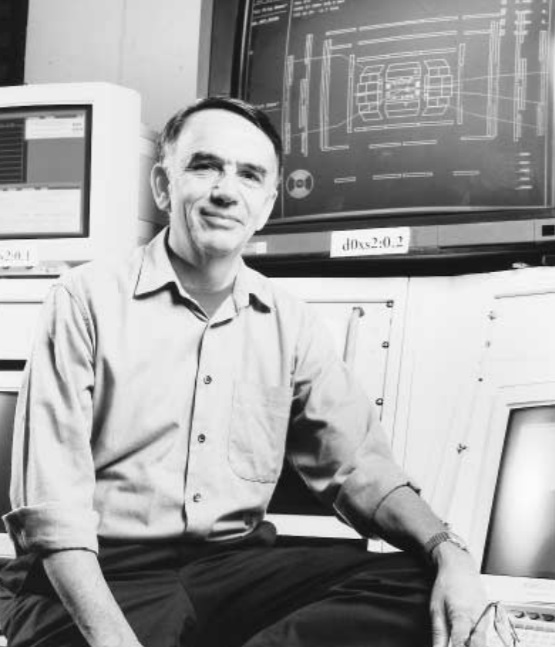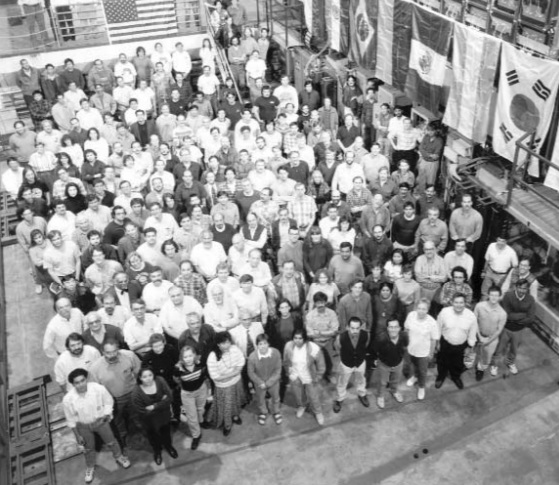The Torch Passes at DZero
Paul Grannis’s retirement as spokesperson for Fermilab’s DZero collaboration marks the end of an era.
His long-time collaborator and cospokesman summed it up. “Paul Grannis is the epitome of DZero,” said Fermilab physicist Hugh Montgomery. “He made the experiment how it is. Not only the experiment, but, for better or worse, how we do business.”
For better or worse was just the beginning. For richer for poorer, in sickness and in health, for so long as there has been a DZero experiment at Fermilab, Paul Grannis has been a part of it. He was the original member and first spokesman of a collaboration that now numbers more than 450, taking his experiment from a mere gleam in Fermilab’s eye to a world-class detector collaboration that—along with sister and competing collaboration CDF—announced the discovery of the top quark in 1995.
On March 3, the day after the announcement of the top quark’s discovery, The New York Times quotation of the day read, “This monster, compared with all the other quarks, is like a big cowbird’s egg in a nest of little sparrow eggs. It’s so peculiar, it must hold clues to some important new physics. —Dr. Paul D. Grannis, leader of one of the groups that found the top quark.”
“Paul has provided exceptional leadership for DZero since 1983 when the Laboratory asked him to form a collaboration and create a proposal for what is now the DZero detector. DZero’s stunning success is in a large measure due to his efforts,” said Fermilab Director John Peoples.
Grannis, a Stony Brook physicist, talks about DZero’s detector with the passion of a teenage boy for his first car. “It will be good to see our old, long-lost friend again,” Grannis said last March, as he waited for the detector to emerge from the Tevatron tunnel at the end of a collider run that had succeeded beyond the collaboration’s dreams. “It will be good to kick its tires and climb around inside it.”
Building DZero’s dreamboat detector was no cakewalk. The experiment began in the early 1980s with a request from then-Director Leon Lederman for a “small, lean experiment” that would use a second interaction point around the proton-antiproton accelerator.
Said Grannis, “Preferably it would be a clever proposal and cost no money. By 1983, the number of proposals had been winnowed down to a few. None was as physically small or clever as Leon wanted. All the proposals were judged [by the Physics Advisory Committee] to be too unambitious.”
Fermilab physicist Gene Fisk, a collaborator since 1986 and now Deputy Head of the DZero Project, said Lederman then appointed Grannis to pull together a team and come up with a conceptual proposal for the new detector.
“Paul got the collaboration together and drew up a more complete design, incorporating good ideas from all the proponents,” Fisk said. “There were several interesting features. Unlike CDF, where one sixth of the accelerator ring was dug up to install a 25-foot-high bypass for the detector, at DZero the Tevatron and Main Ring beams are separated by only 2 meters. That made it challenging and created some constraints for the calorimeter,” he said. He added, “Paul should get credit for pulling the group together that built the detector. The multimillion dollar cost required a lot of effort in the way of justification.”
That is putting it mildly. Through the mid-1980s the collaboration struggled for funding, even as new groups joined DZero to get in on the physics action. “In the early days,” Grannis said, “it was somewhat of an uphill battle, because firstly, CDF had preceded us by four or five years, and were clearly on track to get something into the collider at the time the collider would be turned on. They were under high pressure, and well along at the construction site... Secondly, a detector was proposed at SLAC almost at the same time as DZero. We were competing within the Department of Energy for these two rather comparable-sized detectors. There was a lot of priority given to the SLAC initiative because they, in turn, were in competition with CERN—in electronpositron collisions—and wanted very much to keep on top of that competition. It was a hard start-up for DZero in that sense.”
Under Grannis’s leadership, the project forged ahead with plans not only to build the detector, but also to prepare for the upgrades that are currently underway. “In spring 1990 John Peoples issued a document asking how we were to upgrade DZero,” said Grannis. “The thing that was odd about it was that it was still two years before we started running with the original detector!”
The DZero experiment at last began collecting data in 1992, chasing after the top quark, among many other projects. Because top turned out to be so massive (“a cowbird’s egg!”), experimenters had to accumulate data over several years to find it. DZero’s late start compared to CDF’s was not as severe a handicap as experimenters feared.
“What really mattered for the discovery of the top quark,” said Grannis, “was the operation of the accelerator and the accumulation of data. It was certainly gratifying to see that both CDF and DZero got there together, and I think they truly did.”
Last fall, Grannis decided the time had come to play a new role in the DZero collaboration. In November 1996, the spokesperson’s torch passed from Grannis to Michigan State University physicist Harry Weerts, following DZero’s elections. Fermilab physicist Hugh Montgomery continues to act as cospokesman, a role he has filled since 1993.
Though Weerts is no stranger to the collaboration—he was a charter member—he’s somewhat daunted by the prospect of doing Grannis’s job. “It’s difficult to fill Paul Grannis’s shoes. You could say I’m slopping around in them, and I hope someday to walk in them and know where I’m going. I still have a lot of homework to do,” he said.
As a private citizen in the DZero collaboration, Grannis looks forward to analyzing data in the Top Quark Physics Group, and to teaching advanced classes at Stony Brook. He also serves this year as chair of the Division of Particles and Fields of the American Physical Society.
“As I see it, there is no better opportunity in the world to do first-rate physics than here, this experiment. I would like to do some of my own analysis and participate a little more strongly in the work of my students. I also look forward, after fourteen years, to quitting teaching elementary physics at my university. The only way that I have been able to teach and travel is to teach the introductory course so I could make arrangements to be gone some of the time. I’m looking forward to teaching a real physics course at something other than the introductory level,” Grannis said.
Weerts says Grannis is still willing to advise him in his new capacity as spokesman. Weerts began working in the DZero collaboration while an assistant professor at Michigan State, and served as chairman of the collaboration’s Physics Analysis Committee. His new job involves a different set of skills: staying abreast of all the papers put out by the collaboration, determining where priorities lie between analyses and upgrade projects, and speaking for the collaboration to the rest of the world. He said he’s familiar with the expression that managing physicists is like herding cats, but insisted that being spokesman is even worse. “It’s more like one cat herding 450 other cats,” he said.





